Free Open Source shadcn/ui Templates
Discover beautiful, free and open source templates built with shadcn/ui. Production-ready React components with TypeScript, Tailwind CSS, and Next.js. From dashboards to landing pages, find the perfect starting point for your next project.
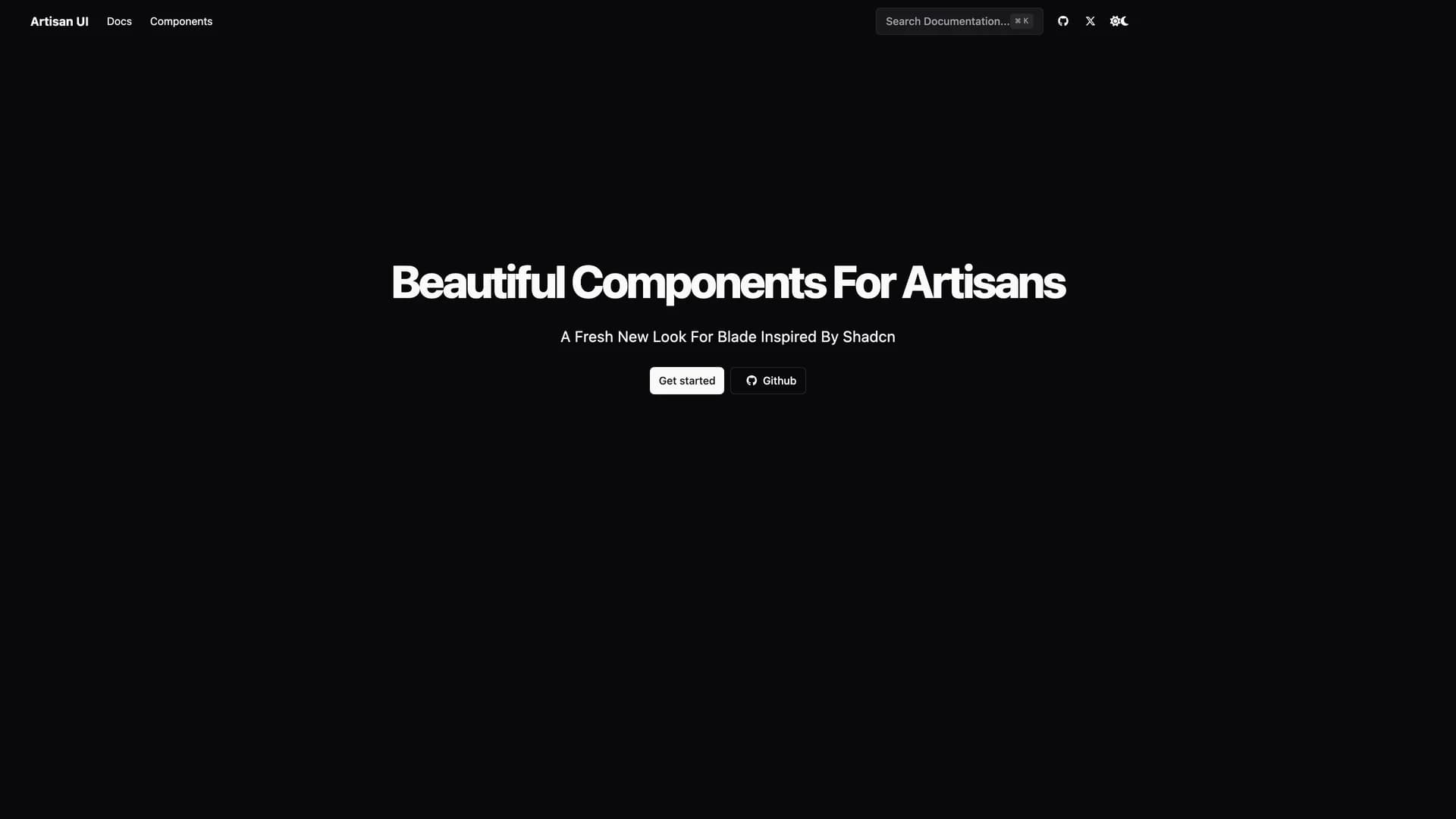
Artisan UI
Artisan UI is a gorgeous component library for Laravel applications built with Blade templating, Tailwind CSS, and AlpineJS, bringing the elegant design philosophy of shadcn/ui to the Laravel ecosystem for developers who prefer server-side rendering over JavaScript frameworks. This work-in-progress library aims to provide Laravel developers with beautiful, accessible components that maintain the simplicity and elegance of shadcn/ui while working naturally with Blade templates and AlpineJS for progressive enhancement. The combination of Tailwind CSS for styling and AlpineJS for lightweight interactivity creates components that are performant, easy to customize, and require minimal JavaScript overhead compared to full React or Vue implementations. Perfect for Laravel developers building traditional server-rendered applications, teams preferring Blade over SPA frameworks, projects where SEO and initial page load performance are critical, or agencies delivering client sites where Laravel's ecosystem advantages (authentication, ORM, queue management) outweigh the benefits of separate frontend frameworks. Released under the MIT license with comprehensive documentation at x-aui.com, Artisan UI demonstrates how component-driven design systems can adapt to different technological ecosystems, enabling Laravel developers to build modern, beautiful user interfaces without abandoning the framework's server-side strengths or adopting complex JavaScript build processes that increase project complexity and maintenance burden.
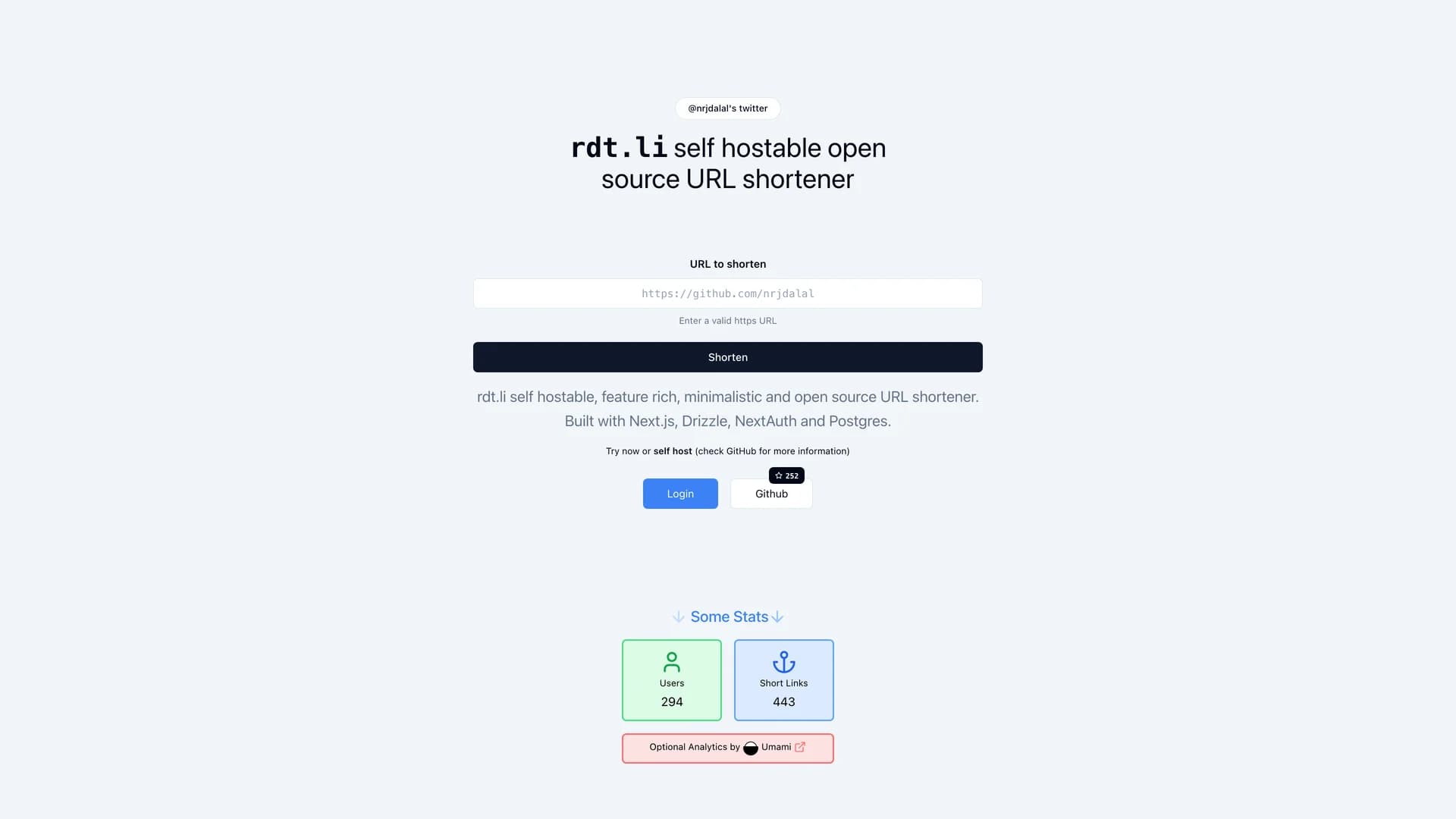
rdt.li
rdt.li is a self-hostable, feature-rich, minimalistic URL shortener built with Next.js 14, Auth.js (NextAuth), Drizzle ORM, and serverless Postgres on Neon, providing comprehensive analytics and modern UX without page reloads. This sleek platform offers all-time, daily, and unique view analytics with bar charts visualizing the last 7 days of traffic, editable URL titles and destinations for flexible link management, filtering and search capabilities for large link collections, and light/dark mode themes for user preference. Built on the "Onset" Next.js starter, the application is designed for easy customization by both beginners and experts while maintaining production-ready quality and performance. Perfect for marketing teams tracking campaign link performance, developers needing custom short URLs for projects, businesses wanting link analytics without third-party service dependencies, or content creators managing numerous links across platforms where analytics inform content strategy. Deployed on Vercel with Neon's serverless PostgreSQL, the architecture scales automatically with traffic while minimizing costs during quiet periods. The no-page-reload experience provides instant feedback on user actions, creating a native-app-like experience in the browser. As an open-source project under MIT license, rdt.li enables complete control over link data and analytics, addressing privacy concerns and vendor lock-in issues inherent in commercial URL shortening services.
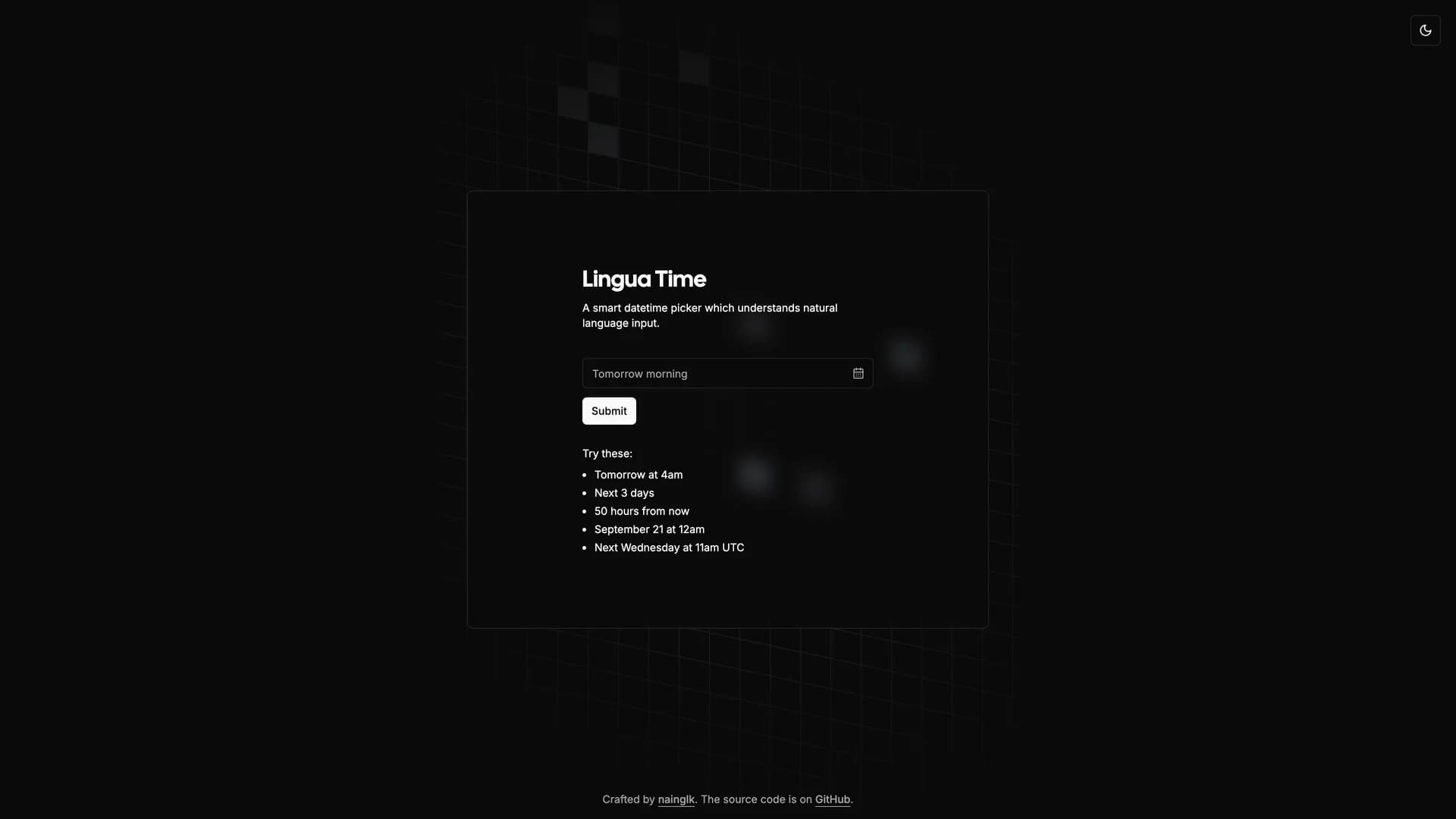
Lingua Time
Lingua Time is a smart datetime picker component built with Next.js, TypeScript, React, Tailwind CSS, and shadcn/ui, understanding natural language input like "next Tuesday at 3pm" to eliminate the tedium of clicking through traditional date pickers. This innovative component parses flexible datetime expressions, provides a user-friendly datetime picker interface as fallback, integrates seamlessly with react-hook-form for validation, and supports various input styles and configurations for different use cases. The natural language parsing capability transforms datetime selection from a multi-click, error-prone process into a simple typing action that matches how people naturally think and communicate about time. Perfect for scheduling applications where users book appointments or meetings, task management tools requiring deadline setting, event planning platforms handling complex timing, or any form where datetime input friction causes user abandonment and reduced completion rates. With straightforward installation via shadcn CLI and comprehensive TypeScript support (95.9% of codebase), Lingua Time demonstrates how rethinking traditional UI patterns with natural language processing can dramatically improve user experience. The component's compatibility with popular form libraries ensures easy integration into existing applications, while the intelligent parsing handles various datetime formats and expressions, reducing validation errors and support requests caused by confused users struggling with conventional datetime pickers that force unnatural interaction patterns.
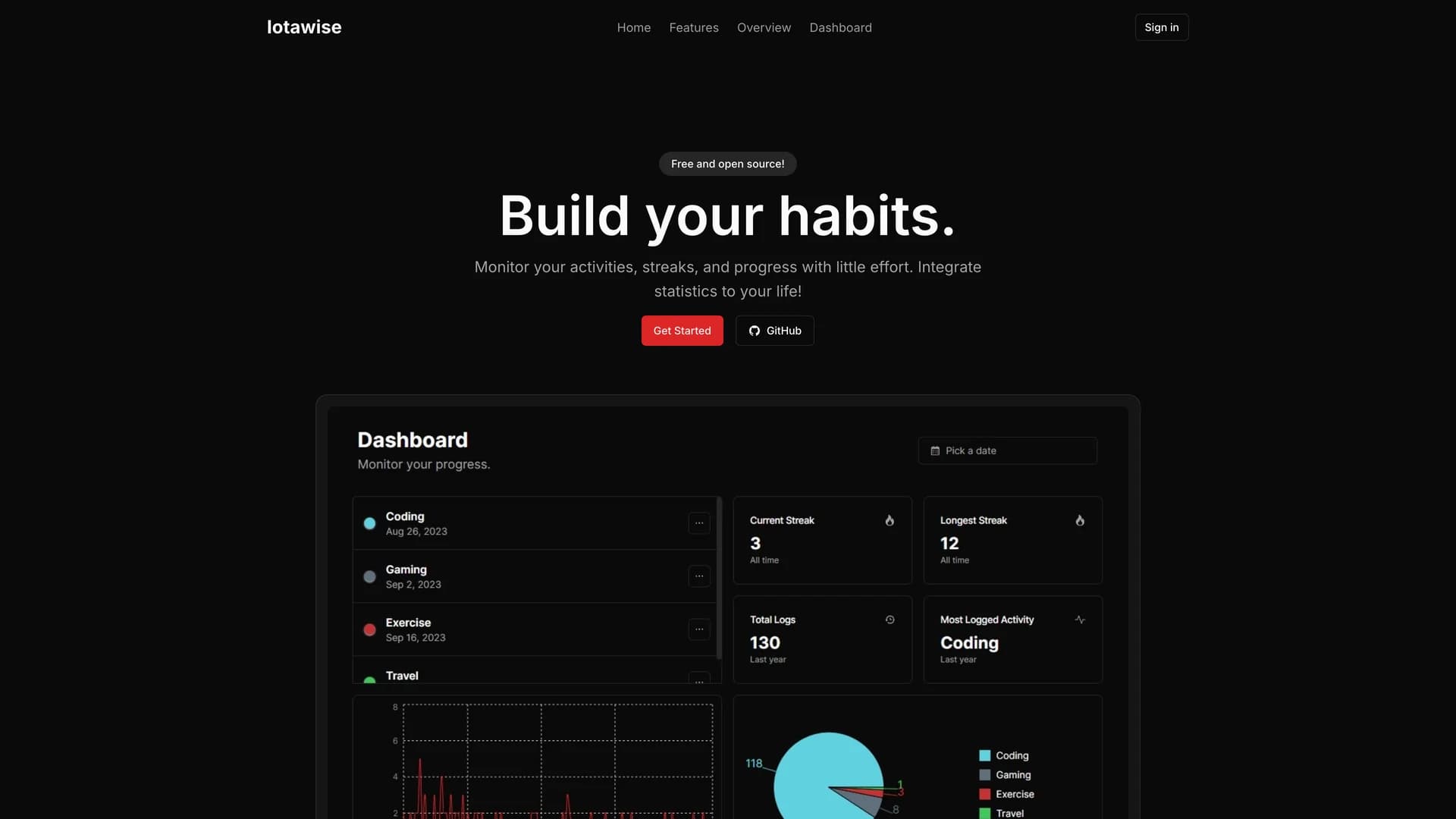
Iotawise
Iotawise is an open-source habit tracking application built with Next.js App Directory, TypeScript, Tailwind CSS, shadcn/ui, NextAuth.js, Prisma ORM, Zod validations, and Neon PostgreSQL, designed to help users monitor and improve daily habits and activities with minimal complexity and maximum insight. This streamlined platform provides a user-friendly interface for daily habit logging, activity streak monitoring to maintain motivation, dashboard analytics visualizing progress and patterns, Google Authentication for quick onboarding, planned web push notifications for habit reminders, and cross-platform PWA support for native-like experiences on mobile and desktop. The application emphasizes simplicity and ease of use, removing barriers that cause users to abandon more complex habit-tracking systems while still providing enough analytics to maintain motivation and identify improvement opportunities. Perfect for individuals building positive routines and breaking negative habits, productivity enthusiasts tracking multiple areas of life improvement, health and fitness goals requiring daily consistency, or anyone seeking behavior change where streak visualization and progress tracking provide the psychological reinforcement needed for long-term habit formation. The combination of NextAuth.js for authentication, Prisma for type-safe database access, and Zod for runtime validation creates a robust, maintainable codebase, while the planned PWA support will enable offline habit logging and push notifications that keep users engaged with their goals throughout the day.
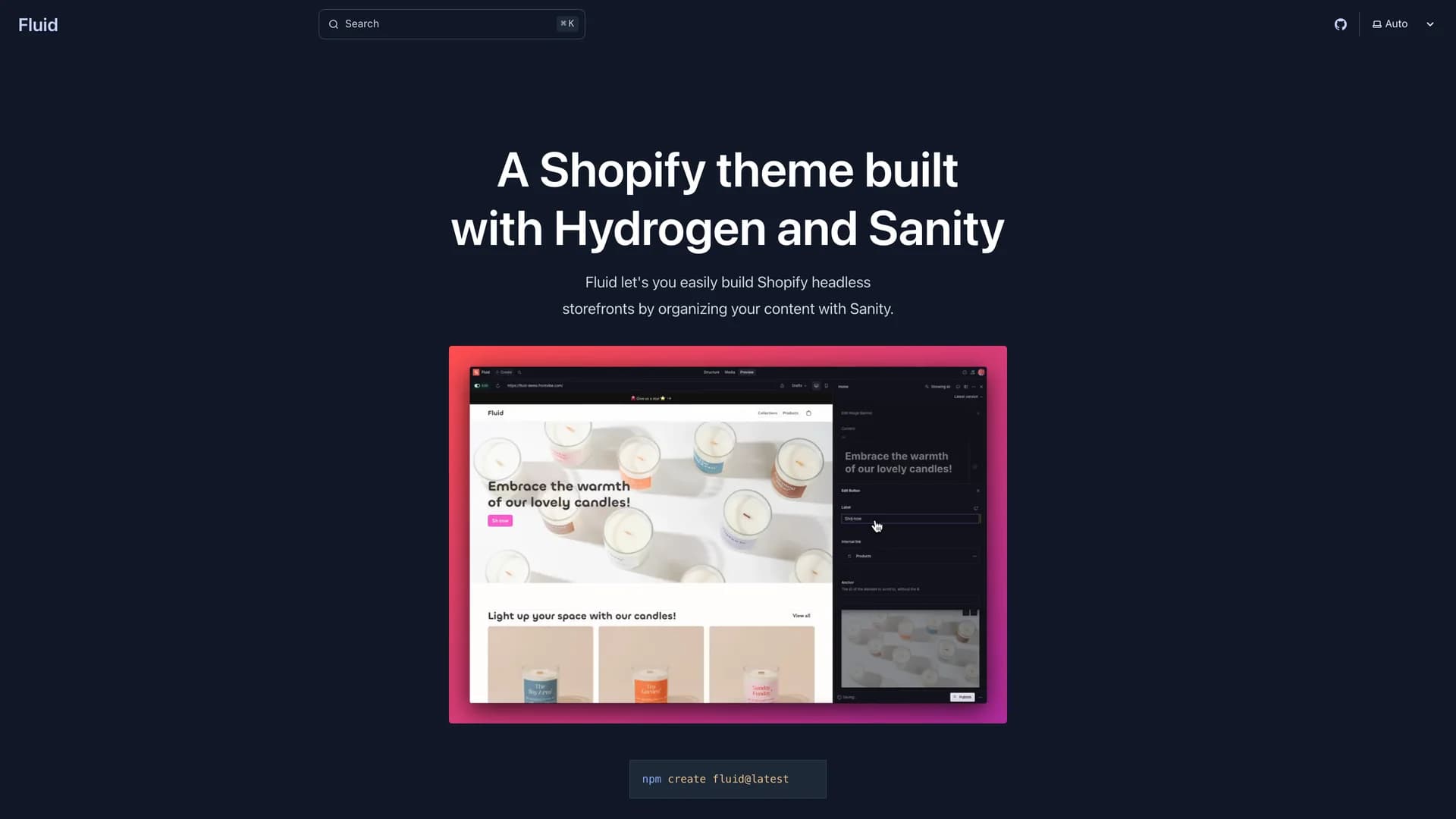
Frontvibe Fluid
Fluid is a Hydrogen theme built with React Router V7, Shopify Hydrogen, React, Tailwind CSS, Sanity CMS, Radix UI, shadcn/ui, Motion, and Embla Carousel, enabling developers to easily build modern headless Shopify storefronts by organizing content with modular sections similar to Shopify Liquid themes. This comprehensive e-commerce solution provides real-time visual editing for content editors, page building through modular, reusable sections, seamless Shopify integration for product data and checkout, and flexible content management with Sanity CMS offering advanced content modeling and preview capabilities. Drawing inspiration from Shopify's Dawn theme, Sanity's Akva demo, the Hydrogen demo store, and Build UI recipes, Fluid combines the best patterns from established e-commerce solutions into a unified, headless architecture. Perfect for brands seeking full design control over their storefronts, agencies building custom e-commerce experiences for clients, growing businesses outgrowing Shopify theme limitations, or any project where content-driven commerce and unique customer experiences differentiate products in competitive markets. The separation of content management (Sanity) from commerce functionality (Shopify) enables marketing teams to iterate on content without developer involvement while developers maintain control over the storefront implementation, performance optimization, and custom features that standard Shopify themes cannot support, creating a scalable foundation for modern e-commerce that adapts to business growth and changing market demands.

Launch UI
Launch UI is a comprehensive Next.js 15 website components template built with TypeScript, Tailwind CSS, shadcn/ui, and Lucide icons, providing pre-built, production-ready UI components specifically designed for products that need great-looking, conversion-optimized landing pages speaking to professional, quality-oriented audiences. This modern design system features fully mobile-compatible components with responsive layouts, dark mode support for user preference, performance and SEO optimization for discoverability, accessibility-focused implementation with ARIA attributes, and multiple pre-built sections including Navbar, Hero, FAQ, Stats, CTA, and Footer components. Created specifically for developer tools, AI-powered applications, SaaS products, mobile apps, and technical product landing pages where first impressions directly impact conversion rates and customer acquisition costs, Launch UI eliminates weeks of design and development work. Perfect for startups launching MVPs with limited design resources, developers building side projects requiring professional presentation, product teams iterating quickly on landing page variations for A/B testing, or technical founders who recognize that poorly designed landing pages undermine product credibility regardless of underlying technology quality. The copy-and-paste approach maintains the flexibility and customization that developers expect from shadcn/ui while providing the cohesive design system and conversion optimization patterns that professional landing pages require, enabling rapid deployment without sacrificing quality or brand consistency.
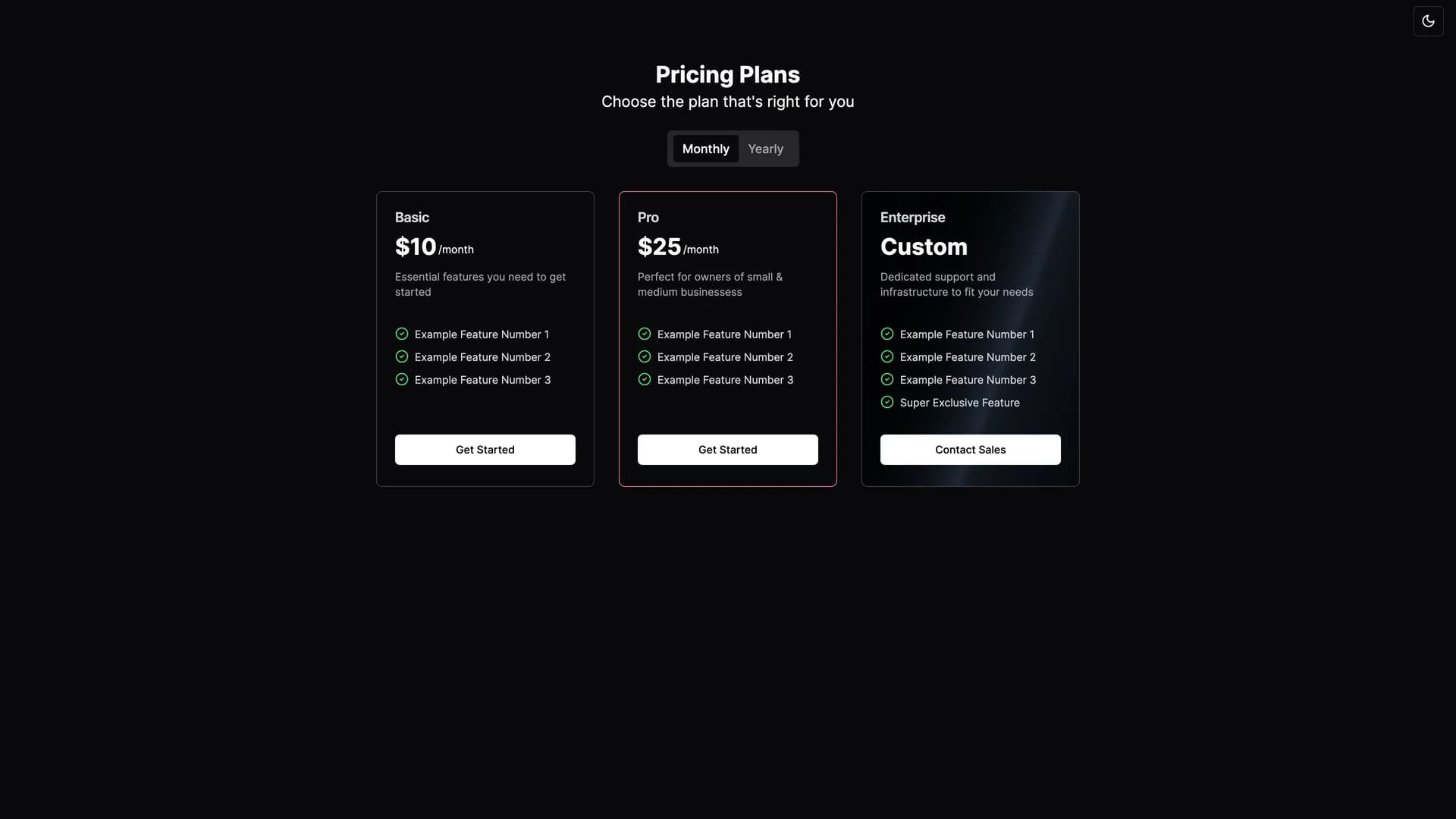
Pricing Page Shadcn
Pricing Page Shadcn is a completely customizable pricing page template built with Next.js 14, TypeScript, shadcn/ui, and Tailwind CSS, designed to provide developers with a ready-to-use, flexible pricing section featuring dark and light mode support, monthly and yearly plan toggles with automatic yearly savings calculations, plan highlighting with "Popular" and "Exclusive" tags for conversion optimization, and responsive design ensuring optimal presentation across all devices. This production-ready component addresses the common challenge that effective pricing pages significantly impact conversion rates and revenue, yet many developers struggle to design pricing tables that are both visually appealing and functionally effective. Perfect for SaaS applications requiring subscription plan presentation, product launches testing different pricing strategies, startups optimizing pricing page conversion rates through A/B testing, or any business where pricing complexity (multiple tiers, billing frequencies, feature comparisons) demands clear visual hierarchy and user-friendly interaction patterns. The automatic calculation of yearly savings eliminates manual updates when pricing changes, while the plan highlighting features enable dynamic promotion of preferred tiers based on marketing strategies or inventory levels. As a fully customizable template, developers can adapt colors, features, pricing structures, and styling to match brand guidelines while maintaining the proven conversion patterns and accessibility standards built into the component, accelerating the path from pricing strategy to implementation.
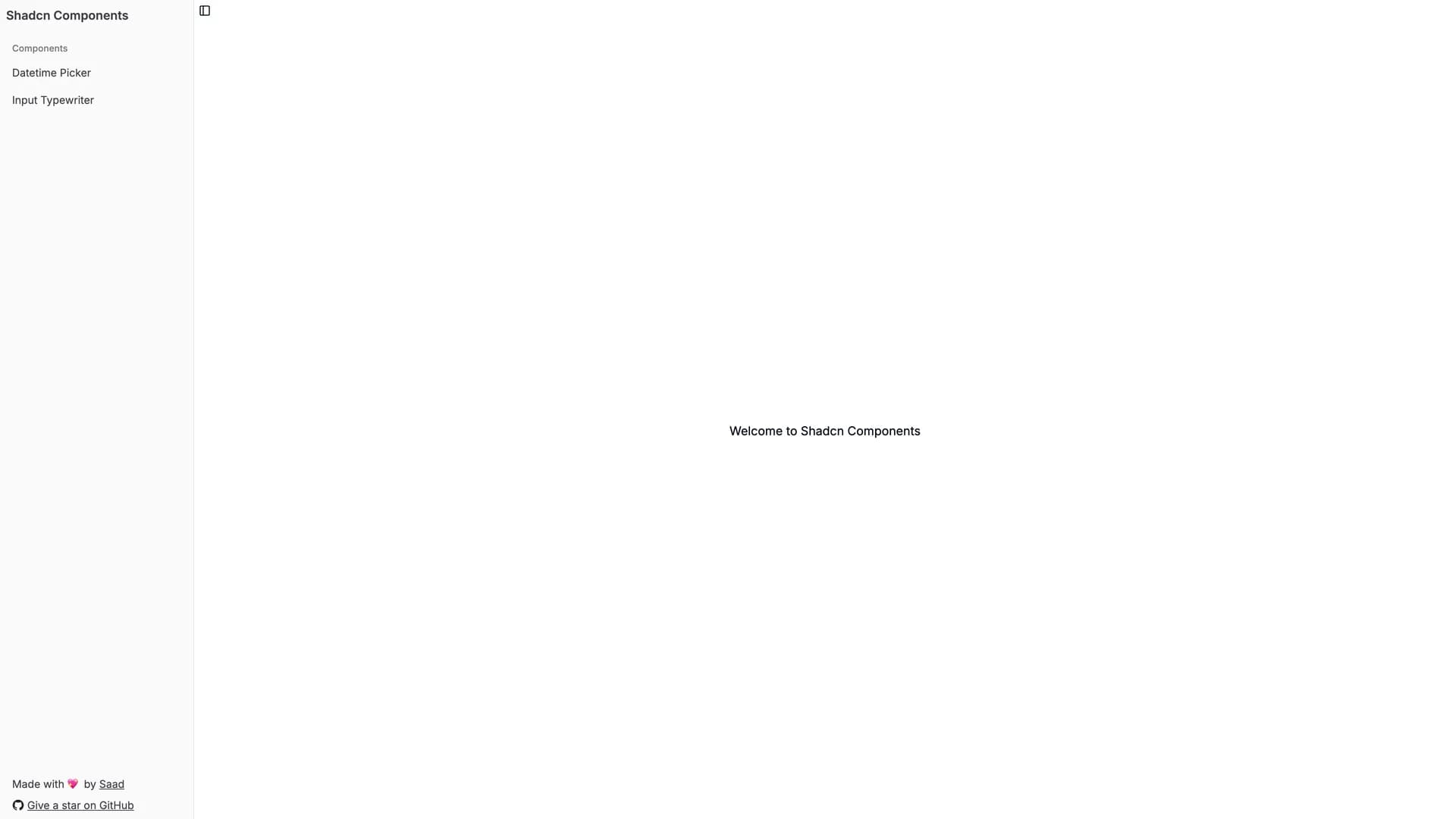
Shadcn Datetime Picker
Shadcn Datetime Picker is a beautifully crafted datetime picker component built with React, Next.js, TypeScript, shadcn/ui, and Tailwind CSS, providing seamless date and time selection, customizable layouts easily adaptable to fit various design requirements, and responsive design ensuring optimal user experience across different devices from mobile to desktop. With a TypeScript-heavy implementation (96% of codebase) ensuring type safety and excellent IDE support, this component addresses the universal need for reliable datetime input in modern web applications while maintaining the aesthetic quality and accessibility standards expected from shadcn/ui components. Perfect for appointment scheduling systems, event registration forms, task management applications with deadline setting, booking platforms handling reservations and availability, or any application where datetime selection is a frequent user interaction that directly impacts data accuracy and user satisfaction. The customizable layout enables developers to adapt the picker's appearance to match specific design systems without fighting against opinionated defaults, while the responsive design ensures consistent functionality whether users interact via touch on mobile devices or mouse and keyboard on desktop workstations. Deployed on Vercel with a live demo for evaluation, this component demonstrates how focusing on visual appeal and user experience can transform a routine form input into a polished interaction that enhances perceived application quality and professionalism.
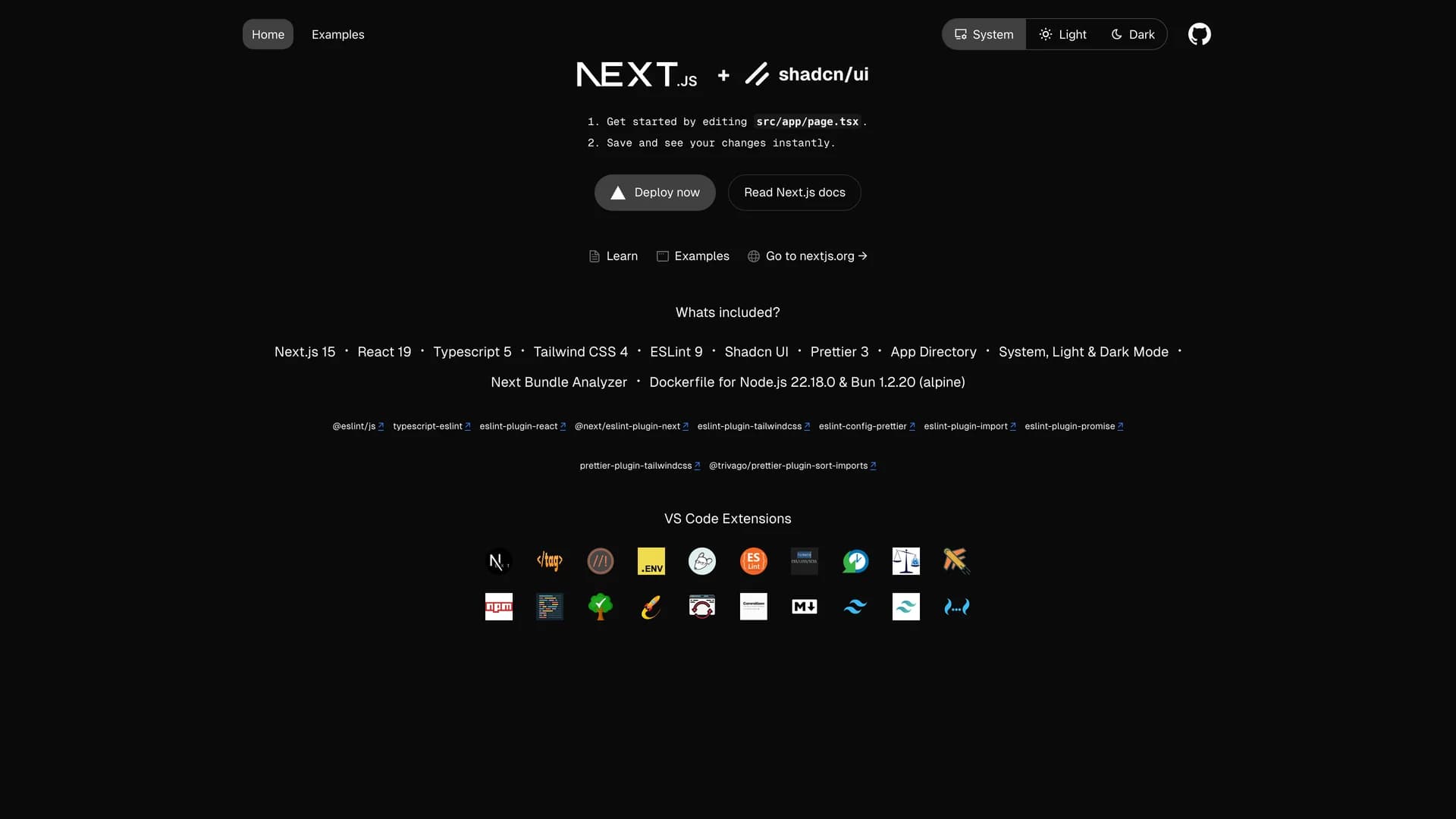
Next.js 15 Starter Shadcn
Next.js 15 Starter Shadcn is a comprehensive starter template built with Next.js 15, React 19, TypeScript 5, Tailwind CSS 4, shadcn/ui, ESLint 9, and Prettier 3, designed to accelerate web development projects with powerful tools and configurations optimized for VS Code development workflows. This robust, opinionated starter features App Directory structure for modern Next.js development, system, light, and dark mode support for user preferences, Next.js Bundle Analyzer for performance optimization, Docker support with both Node.js and Bun configurations for containerization, comprehensive ESLint and Prettier configurations ensuring code quality, recommended VS Code extensions for enhanced developer experience, and cloud development environment options for remote collaboration. Supporting multiple package managers (npm, yarn, pnpm, bun) and providing extensive code quality tooling, this template reduces initial project setup time from hours to minutes while promoting best practices in modern web development. Perfect for development teams standardizing project structure and tooling, agencies delivering consistent client projects, individual developers building multiple applications with similar requirements, or any scenario where reducing boilerplate setup and decision fatigue enables faster progression from idea to implementation. The preconfigured development environment eliminates the common friction of setting up linting, formatting, and build tools, while the Docker configurations ensure consistent development and deployment environments across team members and production infrastructure, creating a foundation that scales from solo projects to team-based development.
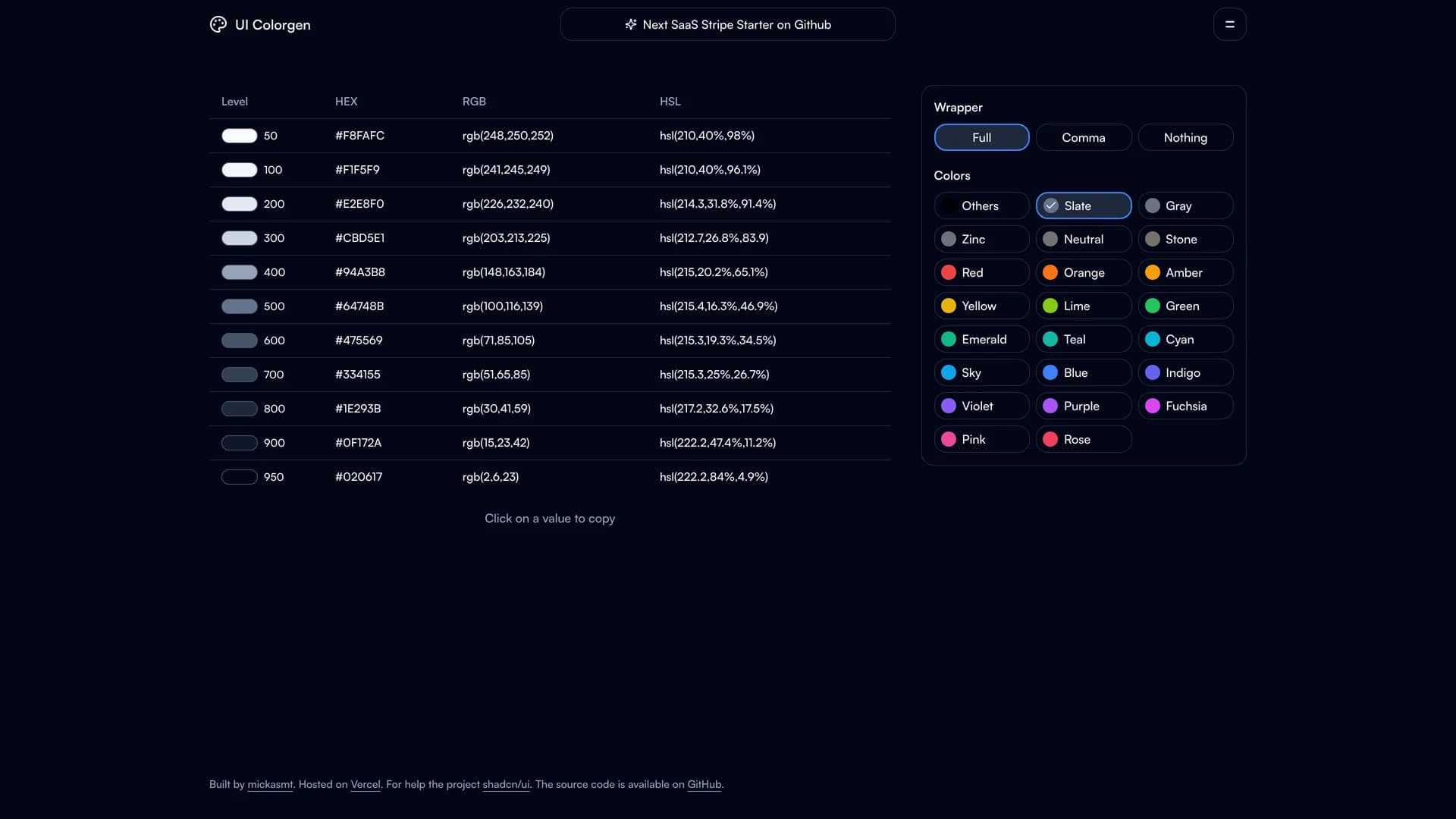
UI Colorgen
UI Colorgen is a web application built with Next.js 14, TypeScript, Tailwind CSS, and Radix UI, designed to simplify shadcn/ui color configuration by providing an interactive interface for listing TailwindCSS colors in multiple formats (hex, rgb, hsl), using a color picker to update CSS variables in real-time, adding custom color variables beyond defaults, selecting initial colors and preferred color formats, generating CSS root variables for theme files, and creating Tailwind color configuration for projects. This specialized tool addresses the complexity of color system setup in shadcn/ui projects where manual CSS variable management becomes error-prone and time-consuming as color schemes evolve. Perfect for design systems teams establishing brand colors across shadcn/ui components, developers implementing client-specific themes in white-label applications, agencies customizing shadcn/ui for multiple clients with different brand guidelines, or any project where efficient color configuration directly impacts development velocity and design consistency. The TypeScript-heavy codebase (94.8%) provides excellent type safety for color manipulation operations, while the multi-format color display helps developers work with colors in their preferred format whether designing in Figma (hex), working with CSS (hsl), or integrating with existing systems (rgb). By generating ready-to-use CSS variables and Tailwind configurations, UI Colorgen eliminates the manual translation between design decisions and code implementation, reducing errors and enabling rapid theme iterations that respond to design feedback or A/B testing results.
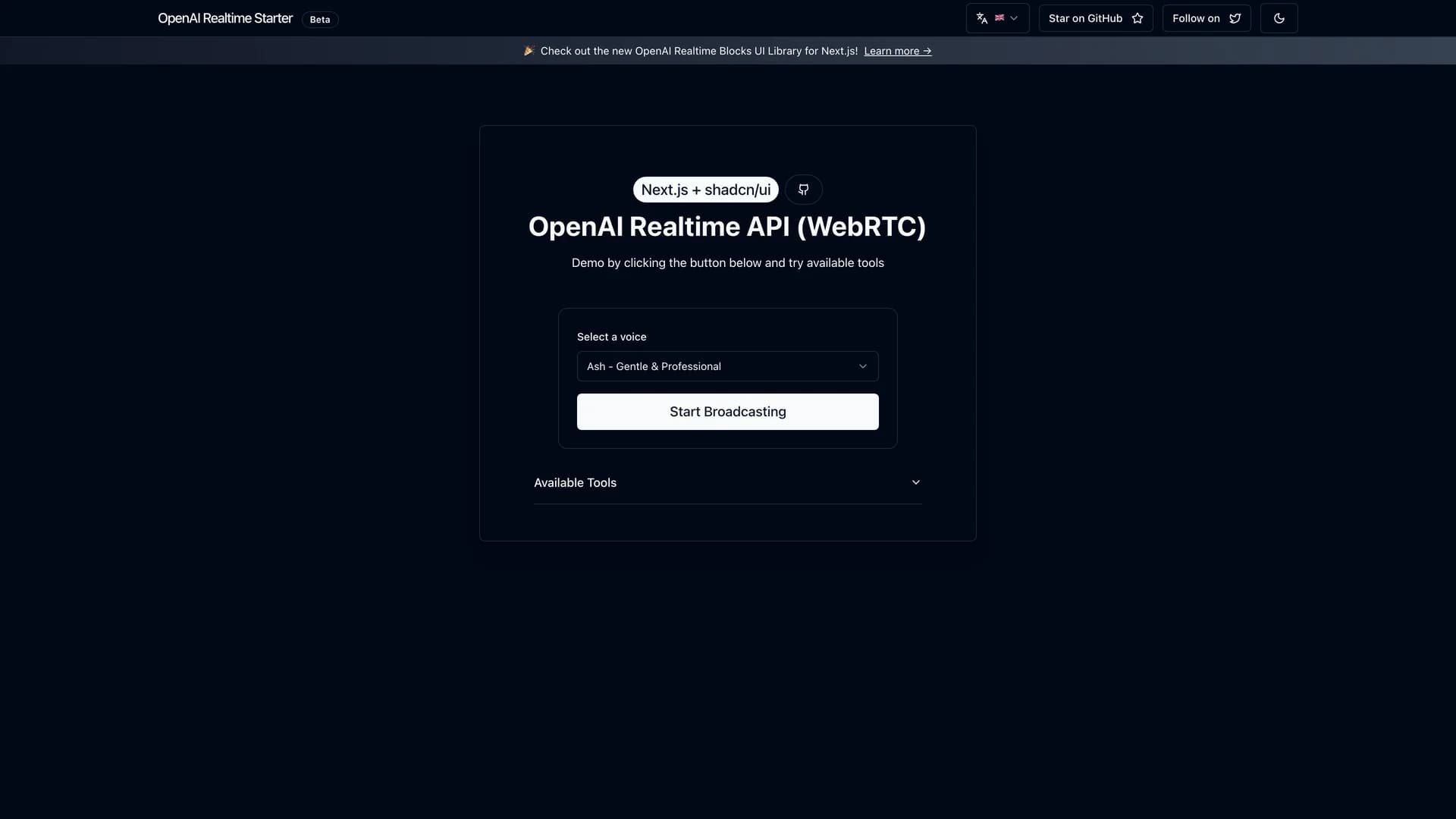
OpenAI Realtime API Next.js
OpenAI Realtime API Next.js is a comprehensive starter template built with Next.js 15, TypeScript, OpenAI Realtime API, WebRTC, Tailwind CSS, shadcn/ui, and Framer Motion, designed for building Voice AI applications with real-time voice interaction capabilities and advanced tool-calling features. This robust framework provides WebRTC-based voice AI streaming for low-latency audio, Next.js server-side rendering for optimal performance, modern UI with smooth animations via Framer Motion, abstracted WebRTC handling through custom React hooks, six example tool-calling functions demonstrating capabilities like getCurrentTime, partyMode, and changeBackground, and multilingual support for English, Spanish, French, and Chinese with strict TypeScript checking ensuring type safety. Supporting both Deno and Node.js runtimes and deployable to Vercel with one-click setup, the template emphasizes ease of use and developer experience while enabling sophisticated voice AI interactions. Perfect for customer service applications with voice-based support, accessibility tools enabling voice control, educational platforms with conversational tutoring, productivity applications supporting voice commands, or any interface where voice interaction provides more natural engagement than traditional text inputs. The custom hook abstraction simplifies WebRTC complexity, enabling developers to focus on application logic and AI capabilities rather than connection management and audio streaming protocols, while the example tool-calling functions demonstrate how voice AI can trigger application actions, creating interactive experiences that respond to user speech in real-time.
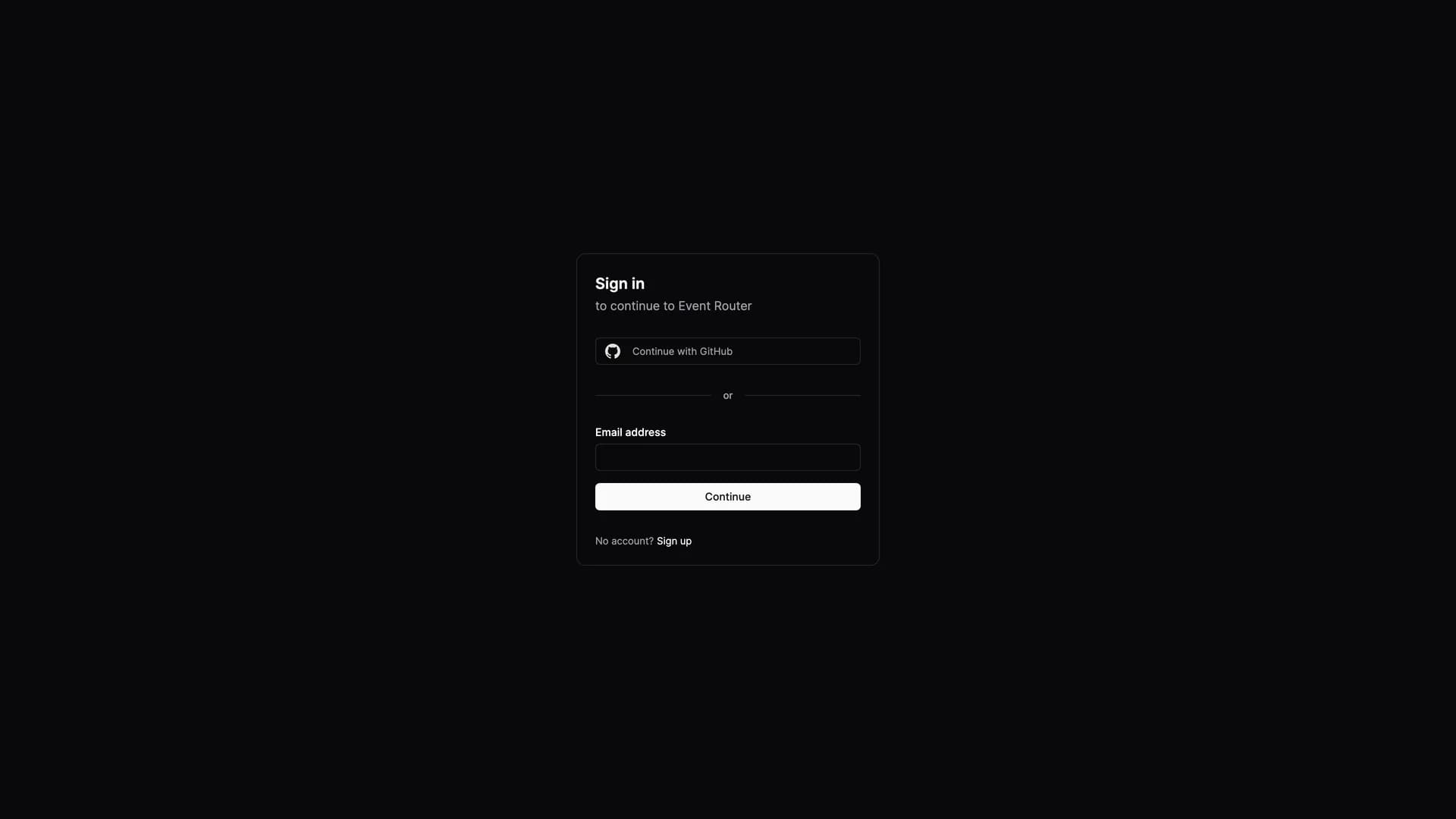
Flowly
Flowly is a study project built with Next.js 13, Tailwind CSS, shadcn/ui, Clerk authentication, and Radix UI, designed to help teams document event-driven architecture by providing structured registration of services, events, event publications and subscriptions, optional markdown descriptions for events, and JSON schema support for event payloads. Currently under development as an educational exercise, Flowly addresses the challenge of maintaining accurate, accessible documentation for event-driven systems where services communicate through asynchronous events rather than synchronous API calls, making system behavior harder to understand and debug. The planned features enable backward-compatible event design, potential TypeScript typing generation from schemas, automatic NPM package publishing for event contracts, and checking for unused event data fields that bloat payloads. Perfect for microservices architectures using event-driven patterns, distributed systems teams maintaining event catalogs, organizations adopting domain-driven design with bounded contexts, or development teams where lack of event documentation leads to integration problems and duplicate event definitions. By centralizing event documentation with schema definitions, Flowly aims to create a single source of truth for event contracts across services, enabling teams to evolve systems confidently by understanding event dependencies, consumers, and schema compatibility before making breaking changes that could cascade through distributed architectures and cause production incidents.
Browse Templates by Category
Discover templates organized by technology, use case, and purpose. Find exactly what you need for your next project.
Tailwind
196 templates
159 authors
React
180 templates
147 authors
Nextjs
160 templates
129 authors
Fullstack
46 templates
43 authors
Radix ui
31 templates
29 authors
Vite
23 templates
20 authors
Drizzle orm
23 templates
22 authors
Ui kits & component libraries
22 templates
20 authors
Prisma
22 templates
19 authors
Templates & themes
16 templates
14 authors
Supabase
12 templates
12 authors
Scss
11 templates
11 authors
Browse Templates by Author
Discover amazing template creators and explore their work. Each author brings their unique style and expertise to the community.
FAQ
shadcn/ui Templates FAQ - Community Questions
Find answers to frequently asked questions about community-made open source shadcn/ui templates, implementation guides, customization tips, and best practices.